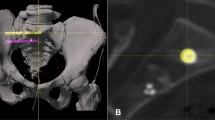Abstract
Background
The exit point of classic iliosacral screw (ISS) is deep and viewing device cannot be used, implantation of ISS may lead to malposition and nerve injury.
Objective
The aim of this study is to explore the effect of ISS implanted through a new channel (NSIS) with the aid of a viewing device.
Methods
With the aid of a viewing device, NISSs were implanted into 50 3D printed pelvis models (1:1), in which the entry point was located at a vertical distance of 6 mm from the middle of the superior posterior quarter of the acetabular rim, and the exit point was the intersection of the vertical extension line of S1 superior articular process and the horizontal median line of S1 transverse process. Screws with diameter of 6.5 mm and 7.3 mm and length of 90 mm were implanted into the left and right sides of the pelvic models, respectively. The implantation was observed. CT scan was performed when penetrating of channel was suspected.
Results
None of the implanted screws perforated the tunnel, but 6.0% (3 models) of the screws were too long and a little bit penetrated (< 4 mm) behind the back of the tunnel, which was found in small models.
Conclusion
The NISS implantation is simple, safe and accurate, but individualized screw implantation with appropriate diameter and length should be more accurate.
Trial registration number
WXSJY-LY-2020-00216, date of registration: June 5, 2020, retrospectively registered.





Similar content being viewed by others
Availability of data and material
Not applicable.
Code availability
None.
Abbreviations
- ISS:
-
Iliosacral screw
- NISS:
-
New iliosacral screw
References
Pan, Z. J., Hong, H. X., Huang, Z. J., Chen, X., Zheng, Q., & Chen, W. Z. (2004). Applied anatomic study of the parameters of screw fixation for the sacroiliac joint. Chinese Journal of Clinical Anatomy., 22(2), 125–128.
Zhang, R., Yin, Y., Li, S., Hou, Z., Jin, L., & Zhang, Y. (2018). Percutaneous sacroiliac screw versus anterior plating for sacroiliac joint disruption: A retrospective cohort study. International Journal of Surgery, 50, 11–16.
Iorio, J. A., Jakoi, A. M., & Rehman, S. (2015). Percutaneous sacroiliac screw fixation of the posterior pelvic ring. Orthopedic Clinics of North America, 46(4), 511–521.
Krappinger, D., Lindtner, R. A., & Benedikt, S. (2019). Preoperative planning and safe intraoperative placement of iliosacral screws under fluoroscopic control. Operative Orthopädie und Traumatologie, 31(6), 465–473.
Li Dong, Ma Yunhong, Zhou Jinhua, et al. Applied anatomical parameters measurement of sacroiliac screw passing the back of sacrum by CT digital reconstructed technology. Chinese Journal of Clinical Anatomy, 2021;39(5): (in press)
M, Braun C, Flatz W, Böcker W, Kammerlander C. Biomechanical stability of sacroiliac screw osteosynthesis with and without cement augmentation. Injury. 2020; S0020–1383(20)30071–1.
Gras, F., Marintschev, I., Wilharm, A., Klos, K., Mückley, T., & Hofmann, G. O. (2010). 2D-fluoroscopic navigated percutaneous screw fixation of pelvic ring injuries—a case series. BMC Musculoskeletal Disorders, 11, 153.
Wei, W., Wang, H., Xia, Z. Y., & Wang, L. (2018). The measurement of the screwing trajectory’s parameters of the sacroiliac screw for iliosacral joint disruption by the computed tomography. Journal of Hebei Medical University, 39(3), 293–296.
Axel, G., Tobias, H., & Krettek, C. (2006). Percutaneous iliosacral screw fixation of unstable pelvic injuries by conventional fluoroscopy. Operative Orthopdie and Traumatologie., 18(3), 225.
Khaled, S. A., & Soliman, O. W. (2015). Functional outcome of unstable pelvic ring injuries after iliosacral screw fixation: Single versus two screw fixation. European Journal of Trauma & Emergency Surgery., 41(4), 387–392.
Collinge, C. A., & Crist, B. D. (2016). Combined percutaneous iliosacral screw fixation with sacroplasty using resorbable calcium phosphate cement for osteoporotic pelvic fractures requiring surgery. Journal of Orthopaedic Trauma, 30(6), e217–e222.
Osterhoff, G., Dodd, A. E., Unno, F., Wong, A., Amiri, S., Lefaivre, K. A., & Guy, P. (2016). Cement augmentation in sacroiliac screw fixation offers modest biomechanical advantages in a cadaver model. Clinical Orthopaedics and Related Research, 474(11), 2522–2530.
Grossterlinden, L., Rueger, J., Catala-Lehnen, P., Rupprecht, M., Lehmann, W., Rücker, A., & Briem, D. (2011). Factors influencing the accuracy of iliosacral screw placement in trauma patients. International Orthopaedics, 35(9), 1391–1396.
Tidwell, J., Cho, R., Reid, J. S., Boateng, H., Copeland, C., & Sirlin, E. (2016). Percutaneous sacroiliac screw technique. Journal of Orthopaedic Trauma, 30(Suppl 2), 19–20.
Elzohairy, M. M., & Salama, A. M. (2017). Open reduction internal fixation versus percutaneous iliosacral screw fixation for unstable posterior pelvic ring disruptions. Orthopaedics & Traumatology, Surgery & Research, 103, 223–227.
Funding
None.
Author information
Authors and Affiliations
Corresponding authors
Ethics declarations
Conflict of interest
The authors have no conflicts of interest relevant to this article.
Ethical Approval
The Review Board approval was obtained for this retrospective study.
Trial registration number
WXSJY-LY-2020–00216, date of registration: June 5, 2020, retrospectively registered.
Consent to participate
The Review Board approved waiving of obtaining informed consent from individual patients for this retrospective study.
Consent for publication
Consent for the publication of images obtained from the patients.
Additional information
Publisher's Note
Springer Nature remains neutral with regard to jurisdictional claims in published maps and institutional affiliations.
Rights and permissions
About this article
Cite this article
Ma, Y., Wang, J., Yin, Q. et al. Effect of Iliosacral Screw Implantation Through a New Channel in Three-Dimensional Printing Pelvic Model. JOIO 56, 244–248 (2022). https://doi.org/10.1007/s43465-021-00467-6
Received:
Accepted:
Published:
Issue Date:
DOI: https://doi.org/10.1007/s43465-021-00467-6




